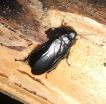Trade winds ventilate the tropical oceans
Kiel marine scientists find explanation for increasing oxygen deficiency
2014-12-19
(Press-News.org) The changes can be measured, but their reasons were unknown. For several decades, scientists have carefully observed that the oxygen minimum zones (OMZ) in the tropical oceans are expanding. These zones are a paradise for some specially adapted microorganisms, but for all larger marine organisms such as fish and marine mammals they are uninhabitable. Thus, their expansion has already narrowed down the habitat of some fish species.
Marine scientists from the GEOMAR Helmholtz Centre for Ocean Research Kiel and the Kiel Collaborative Research Centre (Sonderforschungsbereich, SFB) 754 "Climate - Biogeochemical Interactions in the Tropical Ocean" now have found a possible reason for these changes by using a model simulation of climate and biological processes. As their study shows, the trade winds north and south of the Equator play a crucial role in the supply of oxygen to tropical sea water. "So fluctuations in the trade winds could also be responsible for the observed enlargement of the oxygen minimum zones in recent years," explains Dr. Olaf Duteil, lead author of the study, which has now been published in the international journal Geophysical Research Letters.
OMZs exist in different intensities at the eastern edges of all tropical oceans. Because nutrient-rich water from the depths reaches the surface in these areas plankton thrives particularly well. Therefore large amounts of plankton organisms die there, too. After their death they sink down to the ocean floor. On the way down bacteria start to decompose the biomass. In doing so they consume the oxygen. The largest of these OMZs stretches from the coasts of Chile and Peru far into the Pacific ocean.
At the same time currents at a few hundred meters depth transport oxygen-rich water from the subtropics towards the tropics, where the oxygen minimum zones lie. "One can think of the tropical Pacific Ocean as a bathtub. When I open the tap, I fill the bathtub with water or 'oxygen', respectively. When the siphon is open, too, we lose oxygen at the same time. We then have an instable equilibrium between input and output," explains Dr. Duteil, "If I turn off the tap a little, the tub empties slowly."
As the researchers were able to determine in a computer simulation of the oxygen balance now, the strength of the currents and thus the oxygen flow to the tropics is directly related to the strength of the trade winds. "It is well known that they vary on a decadal time scale," says co-author Prof. Dr. Claus Böning from GEOMAR, "but these variations haven never been investigated in relation to the oxygen budget of tropical oceans. "
Since the trade winds have been in a weak phase since the mid-1970s, this could be the explanation for the observed enlargement of the oxygen minimum zones. "The oxygen bathtub of the tropical oceans is emptying," says Dr. Duteil. Once the trade winds come back into a stronger phase, the process will be reversed.
This does not mean that external processes such as the general global warming have no influence on the oxygen concentrations in the tropical oceans. "There is evidence that global change affects the major wind systems of the Earth. That would have a direct impact on the oxygen transport in the subtropical and tropical ocean," explains Prof. Andreas Oschlies, co-author and speaker of the SFB 754. "But it is important that according to this study the trade winds in any case as must be considered as a factor for long-term development of tropical oxygen minimum zones," Oschlies adds.
INFORMATION:
ELSE PRESS RELEASES FROM THIS DATE:
2014-12-19
PITTSBURGH--University of Pittsburgh researchers have shared their findings from three studies related to shale gas in a recent special issue of the journal Energy Technology, edited by Götz Veser, the Nickolas A. DeCecco Professor of Chemical and Petroleum Engineering in Pitt's Swanson School of Engineering.
In the special issue focusing on shale gas, Pitt faculty authors look at "smart wells" that use wireless communication, wastewater management, and information gaps between legislators, regulators, industry representatives, researchers, and the public on the ...
2014-12-19
Scientists from the Southwest University, Chongqing, China have found a new species and a new subspecies of cockroach. What makes these creepy crawlies distinctive from the cockroaches most of us know is that they don't infest human houses, on the contrary they prefer to live a hermit life drilling logs, hidden away from human eyes. The study was published in the open access journal ZooKeys.
Out of around 4,600 species worldwide, only 30 are the cockroaches associated with human habitats that gives the bad fame of these creatures. The representatives of the genus Panesthia, ...
2014-12-19
Most parents are not surprised by the irregularity of a newborn infant's sleep patterns, but by six months or so many parents wonder if something is wrong with their baby or their sleeping arrangements if the baby is not sleeping through the night. Healthcare providers, specifically nurse practitioners, can help parents understand what "normal" sleep patterns are for their child, according to researchers.
"Nurse practitioners are at the frontline of healthcare," said Robin Yaure, senior instructor of human development and family studies, Penn State Mont Alto. "They are ...
2014-12-19
Jacksonville, FL (December 19, 2014) - Investigators have found that young children with type 1 diabetes (T1D) have slower brain growth compared to children without diabetes. A new study, published in the December issue of Diabetes, now available ahead of print, suggests that continued exposure to hyperglycemia, or high blood sugars, may be detrimental to the developing brain. The research was supported by the National Institutes of Health (NIH).
"Our results show the potential vulnerability of young developing brains to abnormally elevated glucose levels, even when ...
2014-12-19
(MEMPHIS, Tenn. - DECEMBER 18, 2014) A study led by St. Jude Children's Research Hospital scientists has identified the population of white blood cells that tumors use to enhance growth and suppress the disease-fighting immune system. The results, which appear in the December 18 edition of the scientific journal Immunity, mark a turning point in cancer immunology and provide the foundation for developing more effective immunotherapies.
For years, researchers have known that a diverse group of white blood cells called myeloid-derived suppressor cells (MDSC) are more abundant ...
2014-12-19
In a previous randomized controlled trial, Stanford University researchers developed two curricula for Girl Scouts to use energy more efficiently: one on energy use at home, and the other in transportation and food. Both courses were effective for girls in the short term, and the home energy course was effective for girls in the long term and for parents in the short term.
Subsequently, the Northern California Girl Scouts began disseminating the programs via manuals and reusable materials, but that method of disseminating the programs has not lead to widespread use.
On ...
2014-12-19
[Boston, MA December18, 2014] Parents of children involved in an elementary school-based community intervention to prevent obesity appear to share in its health benefits. A new analysis of Shape Up Somerville: Eat Smart Play Hard™ shows an association between being exposed to the intervention as a parent and a modest decrease in body mass index (BMI) compared to parents in two similar control communities. The study led by researchers at the Friedman School of Nutrition Science and Policy at Tufts University and the Centers for Disease Control and Prevention (CDC) ...
2014-12-19
University of Chicago developmental neuroscientists have found specific brain markers that predict generosity in children. Those neural markers appear to be linked to both social and moral evaluation processes.
There are many sorts of prosocial behaviors. Although young children are natural helpers, their perspective on sharing resources tends to be selfish. Jean Decety, the Irving B. Harris Professor of Psychology and Psychiatry, and Jason Cowell, a postdoctoral scholar in Decety's Child NeuroSuite lab, wanted to find out how young children's brains evaluate whether ...
2014-12-19
Australian scientists have developed a model for oil palm cultivation, aimed at helping growers of the crop maximize the yields of their plantations, while minimizing detrimental environmental impacts.
The model was recently published in the journal Environmental Modeling & Software.
"Oil palm has become a major crop in the tropics, cultivated on more than 39 million acres of land," co-author Dr Paul Nelson of James Cook University (JCU) said.
"Demand for the product continues to grow, and the industry is expected to keep expanding in the foreseeable future.
"At ...
2014-12-19
Scientists at A*STAR's Institute of Medical Biology (IMB) and Institute of Molecular and Cellular Biology (IMCB) have identified a genetic pathway that accounts for the extraordinary size of the human brain. The team led by Dr Bruno Reversade from A*STAR in Singapore, together with collaborators from Harvard Medical School, have identified a gene, KATNB1, as an essential component in a genetic pathway responsible for central nervous system development in humans and other animals.
By sequencing the genome of individuals of normal height but with a very small head size, ...
LAST 30 PRESS RELEASES:
[Press-News.org] Trade winds ventilate the tropical oceans
Kiel marine scientists find explanation for increasing oxygen deficiency


